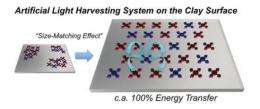September 1, 2011 feature
Artificial light-harvesting method achieves 100% energy transfer efficiency

(�鶹��ԺOrg.com) -- In an attempt to mimic the photosynthetic systems found in plants and some bacteria, scientists have taken a step toward developing an artificial light-harvesting system (LHS) that meets one of the crucial requirements for such systems: an approximately 100% energy transfer efficiency. Although high energy transfer efficiency is just one component of the development of a useful artificial LHS, the achievement could lead to clean solar-fuel technology that turns sunlight into chemical fuel.
The researchers, led by Shinsuke Takagi from the Tokyo Metropolitan University and PRESTO of the Japan Science and Technology Agency, have published their study on their work toward an artificial LHS in a recent issue of the Journal of the American Chemical Society.
“In order to realize an artificial light-harvesting system, almost 100% efficiency is necessary,” Takagi told �鶹��ԺOrg.com. “Since light-harvesting systems consist of many steps of energy transfer, the total energy transfer efficiency becomes low if the energy transfer efficiency of each step is 90%. For example, if there are five energy transfer steps, the total energy transfer is 0.9 x 0.9 x 0.9 x 0.9 x 0.9 = 0.59. In this way, an efficient energy transfer reaction plays an important role in realizing efficient sunlight collection for an artificial light-harvesting system.”
As the researchers explain in their study, a natural LHS (like those in purple bacteria or plant leaves) is composed of regularly arranged molecules that efficiently collect sunlight and carry the excitation energy to the system’s reaction center. An artificial LHS (or “artificial leaf”) attempts to do the same thing by using functional dye molecules.
Building on the results of previous research, the scientists chose to use two types of porphyrin dye molecules for this purpose, which they arranged on a clay surface. The molecules’ tendency to aggregate or segregate on the clay surface made it challenging for the researchers to arrange the molecules in a regular pattern like their natural counterparts.
“A molecular arrangement with an appropriate intermolecular distance is important to achieve nearly 100% energy transfer efficiency,” Takagi said. “If the intermolecular distance is too near, other reactions such as electron transfer and/or photochemical reactions would occur. If the intermolecular distance is too far, deactivation of excited dye surpasses the energy transfer reaction.”
In order to achieve the appropriate intermolecular distance, the scientists developed a novel preparation technique based on matching the distances between the charged sites in the porphyrin molecules and the distances between negatively charged (anionic) sites on the clay surface. This effect, which the researchers call the “Size-Matching Rule,” helped to suppress the major factors that contributed to the porphyrin molecules’ tendency to aggregate or segregate, and fixed the molecules in an appropriate uniform intermolecular distance. As Takagi explained, this strategy is significantly different than other attempts at achieving molecular patterns.
“The methodology is unique,” he said. “In the case of usual self-assembly systems, the arrangement is realized by guest-guest interactions. In our system, host-guest interactions play a crucial role for realizing the special arrangement of dyes. Thus, by changing the host material, it is possible to control the molecular arrangement of dyes on the clay surface.”
As the researchers demonstrated, the regular arrangement of the molecules leads to an excited energy transfer efficiency of up to 100%. The results indicate that porphyrin dye molecules and clay host materials look like promising candidates for an artificial LHS.
“At the present, our system includes only two dyes,” Takagi said. “As the next step, the combination of several dyes to adsorb all sunlight is necessary. One of the characteristic points of our system is that it is easy to use several dyes at once. Thus, our system is a promising candidate for a real light-harvesting system that can use all sunlight. We believe that even photochemical reaction parts can be combined on the same clay surface. If this system is realized and is combined with a photochemical reaction center, this system can be called an ‘inorganic leaf.’”
More information: Yohei Ishida, et al. “Efficient Excited Energy Transfer Reaction in Clay/Porphyrin Complex toward an Artificial Light-Harvesting System.” Journal of the American Chemical Society. DOI:10/1021/ja204425u
Copyright 2011 �鶹��ԺOrg.com.
All rights reserved. This material may not be published, broadcast, rewritten or redistributed in whole or part without the express written permission of �鶹��ԺOrg.com.


















